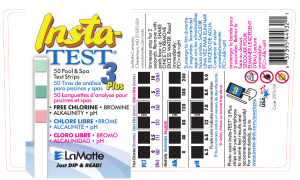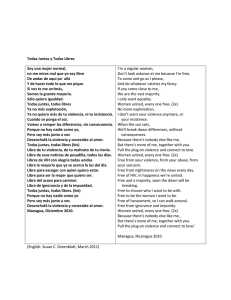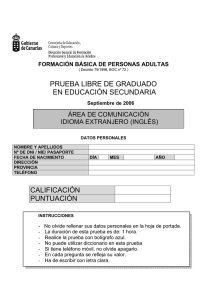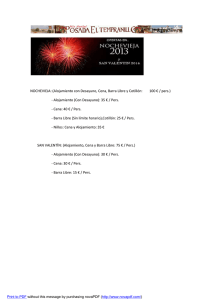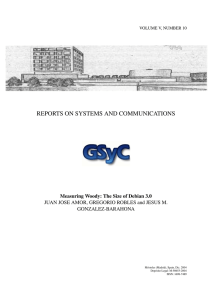Libre software computer science classes - IEEE Software
Anuncio
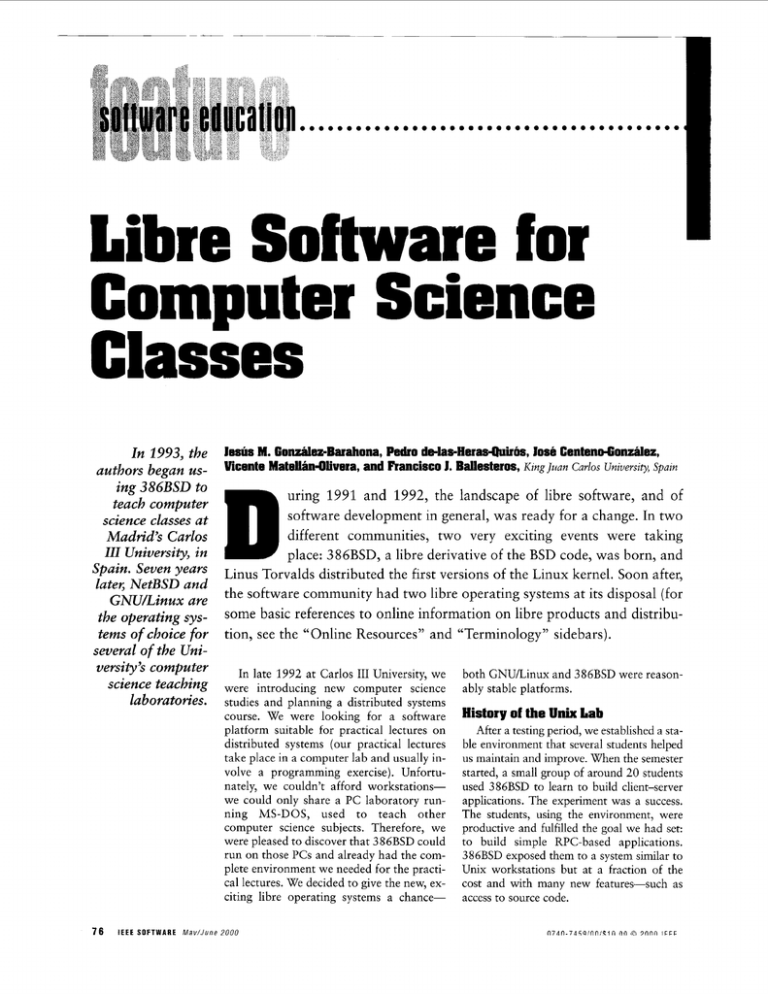
..................mm ........... e........ Computer Science Classes In 1993, the authors began using 386BSD to teach computer science classes at Madrid’s Carlos III University, in Spain. Seven years later, NetBSD and GNU/Linux are the operating systems of choice for several of the University’s computer science teaching laboratories. 76 I Jesus M. ConxirlmBarahona, Pedro delaeHeras-Quiibs,Jose Centeno&mhIez, Vicente Matdhn-Oliverr, and Francisco 1. Ballesteros, i h g ]tian C U ~ O SUniverszty, S ~ U W Z D uring 1991 and 1992, the landscape of libre software, and of software development in general, was ready for a change. In two different communities, two very exciting events were taking place: 386BSD, a libre derivative of the BSD code, was born, and Linus Torvalds distributed the first versions of the Linux kernel. Soon after, the software community had two libre operating systems at its disposal (for some basic references to online information on libre products and distribution, see the “Online Resources” and “Terminology” sidebars). In late 1992 at Carlos I11 University, we were introducing new computer science studies and planning a distributed systems course. We were looking for a software platform suitable for practical lectures on distributed systems (our practical lectures take place in a computer lab and usually involve a programming exercise). Unfortunately, we couldn’t afford workstationswe could only share a PC laboratory running MS-DOS, used to teach other computer science subjects. Therefore, we were pleased to discover that 386BSD could run on those PCs and already had the complete environment we needed for the practical lectures. We decided to give the new, exciting libre operating systems a chance- I E E E S O F T W A R E M a v N u n e 2000 both GNU/Linux and 386BSD were reasonably stable platforms. History of the Unix Lab After a testing period, we established a stable environment that several students helped us maintain and improve. When the semester started, a small group of around 20 students used 3 86BSD to learn to build client-server applications. The experiment was a success. The students, using the environment, were productive and fulfilled the goal we had set: to build simple RPC-based applications. 386BSD exposed them to a system similar to Unix workstations but at a fraction of the cost and with many new features-such as access to source code. n 7 ~ n - 7 ~ ~ q i n n i fnn fin a 7nnn I F F F The NetBSD operating system Although several problems were evident-the lack of a GUI and several common applications, difficulties with maintenance, and trouble with some of the hardware devices-we decided to continue using systems based on libre software. After considering GNU/Linux, we selected NetBSD, a successor of 386BSD, as the new operating system for several reasons: Familiarity: Our background was mainly in BSD-derived systems, such as SunOS. Quality: BSD’s networking code was said to be better, especially regarding NFS. Availability of bibliographies: books about BSD and its networking code were widely known.1J We didn’t consider any proprietary systems, in part because of budget constraints, but also because it was obvious to us at the time that NetBSD, and perhaps GNU/Linux, were technically the best available Unix-like systems for PCs. We compiled most of the applications from source code, because NetBSD lacked a collection of binary packages. Therefore, a lot of source code was always around, and interested students could look at the code that experienced programmers had written-an activity uncommon in Spain (and in many other parts of the world) at that time. In 1994, our department allocated funds for buying new PCs and developing the Unix Lab. Thus, we introduced our first libre software laboratory. We devoted the next two years to improving the Unix Labfurther integrating it with classroom work and lectures and polishing the user interface. Although GNU/Linux was quickly becoming a viable alternative, we were still committed to BSD derivatives and, in particular, to NetBSD. However, students started asking for GNU/Linux, and colleagues in the Computer Science Department pressured us to switch so they could run Linux-only applications. Looking back, it is astounding that we had almost no pressure to switch to proprietary Unix-like systems. The new environment was much more user-friendly. We installed XFree86 in every computer, with a GUI that provided a faster learning curve for students. We also installed new applications, many of them with a GUI. The switch to GNU/Linux In 1997, the department decided to renew and expand the Unix Lab. Because of the social pressure for moving toward GNU/Linux, we decided to install it instead of NetBSD in the new hardware. Among the many distributions of GNULinux, we considered RedHat, Slackware, and others, but we chose Debian because of I I I H its development model, which was based on hundreds of developers spread around the world; the number of included applicationsaround 1,000 at the time; the development team’s spirit, open to external suggestions and fully committed to libre software; and advanced package management tools, which simplified large-scale upgrades. The new Unix Lab required no funding for buying software, letting us allocate additional funds to improved networking hardware and multimedia equipment. This let students use MBone applications for establishing, for instance, video conferences. The switch to GNULinux has proven beneficial for students, because it is more extensively used in Spain than NetBSD and is much easier to obtain. Currently, the lab runs Debian 2.1 (which includes almost 2,000 packages), with an improved GUI based on Gnome. More and more teachers (in computer science departments and elsewhere) are using or planning to use GNU/Linux for their practical assignments, and we are sharing our M a y / J u n e 2000 IEEE SOFTWARE 77 Jesus M. Gonxalez Barahona teaches at the King Juan Carlos University, Mostoles, Spain. He ioined the Computer Science Department of the Carlos 111 University, Leganes, in 1992, where he worked until September 1999. His current research interests are distributed systems, multicasl protocols, and fault-tolerant systems. He is also interested in the technical and teaching implications of libre software. He received his PhD in telecommunication engineering from Universidad Politecnicaof Madrid. He is a member of the IEEE Computer Society and of AT1 (Association of Computing Technicians). Contact him al [email protected] or [email protected]. they gained immense learning value by being able to inspect the internals of the software and system. Similarly, all the teaching materials (including the software) are available to students and colleagues at other universities Pedro de-las-HerasQuiros teaches at the King Juan Carlos University, Mostoles, without restrictions. We can thus easily share Spain. He worked at the Computer Science Department of Carlos 111 University, Leganes, until Oclober 1999. His researchinterests include distributed systems, fault tolerance, and largeour teaching tools and techniques with colscale network protocols and applications. He is also interestedin the impad of libre software leagues. Another advantage is that libre softin the software industry and academic circles. He earned an MS in computer science from the ware ensures “brand-neutral” teaching-any Universidad Politecnicaof Madrid and expects to receive a PhD in computer science during 2000 from the same University. He is a member of the IEEE, ACM, and ATI. Contact him at reseller can provide the software because no [email protected]. one owns it. This way, the University doesn’t endorse any particular brand or company. Jose Centeno-GonzAlexteaches at the King Juon Carlos University, Mostoles, Spain. Also, source code availability for computer He ioined the Computer Science Departmenl of Carlos 111 University, Leganes, in 1993, where science students is extremely important so he worked until September 1999. His research interests include distributed-systems programming, and protocols for distributed systems. He is also interestedin the impact of libre softthey can learn how other programmers solve ware on computer science teaching and industry. He graduated from Universidad Politecnicaof common problems. Because of the availability Madrid with an MS in electrical engineering and expects to receive a PhD i n computer science of source code, we were able to customize from the same university this year. Contact him a1 [email protected]. and adapt the software to our environment. This included porting rare applications to the operating system we were using. Vicente Matellan Olivera teaches at the King Juan Carlos University, Mostoles, Another positive side effect is extremely Spain. He ioined the Computer Science Department of Carlos 111 University, Leganes, in 1993, low software costs. Funding for software where he worked until September 1999. He is interested in muhiagent and distributed systems laboratories is limited, and with libre softand has worked on applying these topics in robotics. He received his PhD in computer science from the UniversidadPolitecnica of Madrid. He is a member of the IAS (Intelligent Autonomous ware, the only significant costs are hardSystems) and A l l (Associationof Computer Science Graduates). Contact him at vmoQgsyc. ware and maintenance. escet.uric.es. In addition, the libre software development model ensures that if a product has a strong enough user base, it will maintain Francisco 1. Ballesterosdoes research on distributed and adaptable operating systems and teaches operating systems and advanced programming courses at the King Juan high quality standards. Among libre softCarlos University, Mostoles, Spain. He received his PhD in computer science from Universidad ware programs, there is a range of technical Politecnicaof Madrid. Conlact him a1 [email protected]. quality, but our experience has been that if you carefully select the system’s components, it is more reliable and capable than its proprietary counterparts. Finally, in several niches, libre software is experiences with almost every university in already the preferred choice. Today, the the Madrid area. most prominent of these niches is probably Lessons Learned the Internet infrastructure and related servAfter many years of operation, the Unix ices. Many of our students are finding jobs Lab has become, for the most part, a posi- in this area because they have some backtive resource. There are, however, both ad- ground in similar or exactly the same mainvantages and disadvantages as compared with a more traditional lab based on pro- prietary software. Advantages The software is available to students without restriction. They can install exactly the same software environment on their home computers with no licensing problems or costs. In addition, they can install more applications for their own use and modify them without bothering with expensive proprietary programs or illegal copying. Moreover, 78 IEEE SOFTWARE M a y i d o n e 2000 stream programs used in that environment. Disadvantages Of course, using libre software for teaching also has its downside. It is sometimes perceived as second class or unprofessional, which can negatively influence the students’ motivation. Similarly, many students feel they need to learn specific characteristics of the socalled standard programs, instead of general skills about using those kinds of programs. Some students are reluctant to install a new operating system on their home computers. There are also institutional barriers to libre students the benefits of a lab based on libre software. Many departments within universi- software. ties are reluctant to use or directly oppose libre Both in Carlos I11 University and King Juan software, not on technical grounds, but based Carlos University, we have helped create on their unfamiliarity with the software. Linux users groups, which are a good source Though less common, we also experienced of informal support for both students and problems regarding a lack of support for cer- teachers using libre software. In those groups, tain hardware devices. we can also find well-trained technical staff to Another problem is that finding technical help maintain the lab. staff well trained in the installation and adWe are very interested in the use of libre ministration of libre software is still not easy. software for teaching computer science and Many of these disadvantages are not di- welcome any comments you have about your rectly related to libre software characteris- experiences in this area. @ tics, but rather to its current situation and perception. Should this situation change in the future, many of these problems will disappear or else turn into advantages. Acknowledgments n October 1999, our team moved to the King Juan Carlos University, and we have already started implementing the lessons learned at the Carlos I11 University. In addition, we are exploring the suitability of libre software for teleteaching and for implementing virtual campus facilities. We are also holding discussions in which we explain to This article, and the experiences it describes, has only been possible thanks to the outstanding work of hundreds of libre software developers. We are very grateful to all of them. References 1. G.R. Wright and W.R. Stevens, TCPIIP Illustrated, Addi- son-Wesley, Reading, Mass., 1995. 2. M.K. McKusick et al., The Design and Implementation of the 4.4 BSD Operating System, Addison-Wesley, Reading, Mass., 1996. s t your company’s Link to career se M a y N u n e 2000 IEEE SOFTWARE 79
